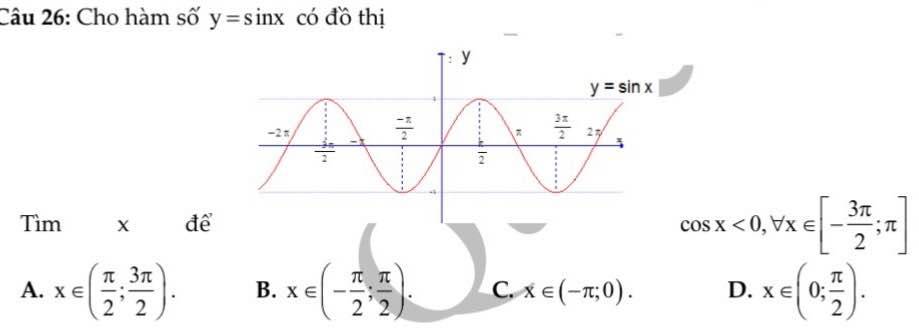
Hãy nhập câu hỏi của bạn vào đây, nếu là tài khoản VIP, bạn sẽ được ưu tiên trả lời.


y = (2 + cosx) / (sinx + cosx - 2) (1)
Ta có: sinx + cosx - 2 = √2.sin(x + π/4) - 2 ≤ √2 - 2 < 0
(1) ⇔ y.(sinx + cosx - 2) = 2 + cosx
⇔ y.sinx + (y - 1).cosx = 2y + 2
Phương trình trên có nghiệm ⇔ y² + (y - 1)² ≥ (2y + 2)²
⇔ y² + y² - 2y + 1 ≥ 4y² + 8y + 4
⇔ 2y² + 10y + 3 ≤ 0
⇔ (-5 - √19)/2 ≤ y ≤ (-5 + √19)/2
Vậy Miny = (-5 - √19)/2
Maxy = (-5 + √19)/2

Phương trình tương đương
\(\left[{}\begin{matrix}x=\dfrac{5\pi}{12}+k\pi\\x=-\dfrac{\pi}{4}+k\pi\end{matrix}\right.,k\in Z\)
Xét họ nghiệm \(x=\dfrac{5\pi}{12}+k\pi,k\in Z\).
Do \(-\dfrac{\pi}{2}< \dfrac{5\pi}{12}+k\pi< \dfrac{8\pi}{3}\) nên \(-\dfrac{11\pi}{12}< k\pi< \dfrac{9\pi}{4}\)
⇒ \(-\dfrac{11}{12}< k< \dfrac{9}{4}\). Mà k ∈ Z nên k ∈ {0 ; 1}
Vậy các nghiệm thỏa mãn phương trình là các phần tử của tập hợp :
S1 = \(\left\{\dfrac{5\pi}{12};\dfrac{17\pi}{12}\right\}\)
Xét họ nghiệm \(x=-\dfrac{\pi}{4}+k\pi\) với k ∈ Z.
Do \(-\dfrac{\pi}{2}< \dfrac{-\pi}{4}+k\pi< \dfrac{8\pi}{3}\) nên \(-\dfrac{\pi}{4}< k\pi< \dfrac{35\pi}{12}\)
nên \(-\dfrac{1}{4}< k< \dfrac{35}{12}\). Mà k ∈ Z nên k∈ {0 ; 1 ; 2}
Vậy các nghiệm thỏa mãn phương trình là các phần tử của tập hợp
S2 = \(\left\{-\dfrac{\pi}{4};\dfrac{3\pi}{4};\dfrac{7\pi}{4}\right\}\)
Vậy các nghiệm thỏa mãn phương trình là các phần tử của tập hợp
S = S1 \(\cup\) S2 = \(\left\{\dfrac{5\pi}{12};\dfrac{17\pi}{12};-\dfrac{\pi}{4};\dfrac{3\pi}{4};\dfrac{7\pi}{4}\right\}\)

a: \(\widehat{\left(SC;\left(ABCD\right)\right)}=\widehat{CS;CA}=\widehat{SCA}\)
Ta có: SA\(\perp\)(ABCD)
=>SA\(\perp\)AC
=>ΔSAC vuông tại A
Vì ABCD là hình vuông
nên \(AC=AD\cdot\sqrt{2}=a\sqrt{2}\)
Xét ΔSAC vuông tại A có \(tanSCA=\dfrac{SA}{AC}=\dfrac{a\sqrt{6}}{a\sqrt{2}}=\sqrt{3}\)
nên \(\widehat{SCA}=60^0\)
=>\(\widehat{SC;\left(ABCD\right)}=60^0\)
b: Ta có: BD\(\perp\)AC
BD\(\perp\)SA
SA,AC cùng thuộc mp(SAC)
Do đó: BD\(\perp\)(SAC)
\(\widehat{SB;\left(SAC\right)}=\widehat{SB;SD}=\widehat{BSD}\)
Vì ABCD là hình vuông
nên \(AC=BD=a\sqrt{2}\)
ΔSAD vuông tại A
=>\(SA^2+AD^2=SD^2\)
=>\(SD^2=\left(a\sqrt{6}\right)^2+a^2=7a^2\)
=>\(SD=a\sqrt{7}\)
ΔSAB vuông tại A
=>\(SA^2+AB^2=SB^2\)
=>\(SB=a\sqrt{7}\)
Xét ΔSBD có \(cosBSD=\dfrac{SB^2+SD^2-BD^2}{2\cdot SB\cdot SD}\)
\(=\dfrac{7a^2+7a^2-2a^2}{2\cdot a\sqrt{7}\cdot a\sqrt{7}}=\dfrac{6}{7}\)
=>\(sinBSD=\sqrt{1-\left(\dfrac{6}{7}\right)^2}=\dfrac{\sqrt{13}}{7}\)
=>\(\widehat{BSD}\simeq31^0\)
=>\(\widehat{SB;\left(SAC\right)}\simeq31^0\)

a. Ta có : \(SA\perp\left(ABCD\right)\Rightarrow BC\perp SA\)
Đáy ABCD là HV \(\Rightarrow BC\perp AB\)
Suy ra : \(BC\perp\left(SAB\right)\Rightarrow\left(SAB\right)\perp\left(SBC\right)\) ( đpcm )
b. \(\left(SBD\right)\cap\left(ABCD\right)=BD\)
O = \(AC\cap BD\) ; ta có : \(AO\perp BD;AO=\dfrac{1}{2}AC=\dfrac{1}{2}\sqrt{2}a\)
Dễ dàng c/m : \(BD\perp\left(SAC\right)\) \(\Rightarrow SO\perp BD\)
Suy ra : \(\left(\left(SBD\right);\left(ABCD\right)\right)=\left(SO;AO\right)=\widehat{SOA}\)
\(\Delta SAO\perp\) tại A có : tan \(\widehat{SOA}=\dfrac{SA}{AO}=\dfrac{a}{\dfrac{\sqrt{2}}{2}a}=\sqrt{2}\)
\(\Rightarrow\widehat{SOA}\approx54,7^o\) \(\Rightarrow\) ...












